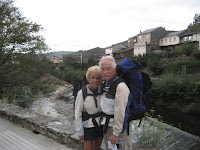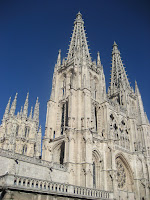
El Camino was a learning experience in so many ways. We knew that a trek of 720km was not going to be easy, but you really don't know the challenges until they are experienced. Hopefully the following list of topics can provide assistance to someone planning to do the same or similar trek.
Accommodations
The accommodations vary – with a greater selection in larger centers – Albergues, Pensiones, Hostals and Hotels. An Albergue is like summer camp where 10-20 sleep together in a room sharing a common bathroom and cooking facility, and in some small towns that might be the only accommodation available. Albergues are general run by the local church and municipality, and there are private albergues, which also may offer private accommodations. Pensiones are usually a private room in a building or home, and usually sharing a common washroom. Hostals are usually cheaper than hotels, but offer a room with a bathroom.
Backpack
Don't go cheap on the backpack. This will be your best friend or worst enemy depending on the type of backpack you have. Therefore learn the basics about the adjustments on the shoulders and hips. Most of the weight should be on your hips, therefore ensure your pack has good hip padding. In regards to weight, we learned on the trail that many peregrinos, as a rule of thumb were packing a little over 10% of their body weight. That is a good rule of thumb, but it does limit certain essentials. I was packing about 17% of my body weight (20% with food and water), which was far too much. However, packing for a short trek will be very different for one like El Camino where you will experience temperature changes from region to region and temperature changes from the start to end of the trek. Also learn how to pack your clothes and gear. We used large zip-lock baggies to separate out the different clothes. This works well to pack and unpack your backpack, and keeps clothes dry in case of rain.
Backpack covers
It will rain, therefore keep the pack covers handy to slip on when it starts to rain. Many peregrinos pulled out light-weight ponchos that also covered their backpacks.
Banks
Bank machines are in most larger villages. The limit is 300 Euros per withdrawal per day. Don't bring traveler cheques. No one knows what they are.
Bedding
Albergues do not normally provide bedding, therefore you should bring a light-weight sleeping bag (2lb) and/or sleeping bag liner.
Budget
Life on El Camino can be inexpensive. Albergues 4-8Euros, Pensiones/Hostal 35-45Euros, dinners (salad, main course, wine, desert) 8-10Euros. Many albergues have kitchens and you can cook your own dinners.
Climate and Weather
Climate and weather conditions will vary by region, elevation above sea level and time of year. On El Camino we started August 29th and completed October 1st – experiencing the heat of the late summer and the rains of the early fall. Therefore be prepared for rain and heat – they can both be deadly.
Clothing
What ever you bring make sure it is quick drying. You will need to wash daily your socks, and frequently your underwear and t-shirt. Most albergues have washing facilities and some will do the wash for you for a fee. Bring a short line and clothes begs in case they are not provided by the pensione/hostal. Most albergues have drying lines to use.
Culture
When you enter another country don't expect things to be the same as home. Most noticeable is the closure of stores between 2:30-5:30 Monday to Friday, early closure on Saturday and closure on Sunday. Therefore if you are looking for services on Sunday forget it. The only service is at the church. Therefore plan your food shopping around store hours. Also, in Spain (and other Mediterranean countries) lunch and dinner are not at the same hours as in north America. The Spaniards eat their lunch late (1:30) and their dinners even later (9pm), which is out of sync with the peregrino schedule – up between 6:30-7:00, walking for 5-7hours, with lunch at noon and dinner by 7pm and in bed and sleeping by 10pm.
Drinks
There are plenty of bars and cafes to stop during the camino, but there are also many stretches of the camino without a village to stop at. Make sure you carry enough water. Dehydration is a serious problem in the desert region of the camino.
Flashlight
This is an essential piece of equipment that assists with early morning packing (in the dark), late night trips to the bathroom and early morning starts in the dark.
Food
If you are a vegetarian you will be cooking your own meals or having “ensalada mixta” at the restaurant every night. Spaniards love their meat and fish, which is why I enjoyed eating out. Most restaurants on the camino have a “peregrino menu”, which doesn't change much from village to village. For 8-10 Euros you get a first course (salad, pasta or soup), second course (beef, pork, chicken or fish), dessert (love the flan) and drink (bottle of wine). Note: wine is cheaper and more plentiful than water.
Guide book
Get a good guide with a detail of the trek and of accommodations. It is possible to book your accommodations in advance and some peregrinos send their packs ahead if they are having difficulties. It's convenient to have phone numbers available.
Internet
Most, but not all villages have internet access, and when they do most albergues have internet access (1Euro for 20-30 minutes). If you have your own computer, many villages will not have WiFi, but larger centers do, therefore access will be restricted to those larger towns.
Language
Learn a little of the language of the country you are visiting. When entering small villages, older people tend not to understand English and therefore you will have to communicate in their language. We found that younger people and people living in larger towns were more likely to have a small and better understanding of the English language, but it is not always the case.
Pain
You will experience pain – sore shoulders and sore feet, and most likely blisters. Do your research on treating blisters and bring enough bandages to deal with small blisters and cuts. Your back will get sore, as will the bottoms of your feet, and it's amazing how a pain pill can help you complete the day's journey with comfort. Remember your feet are not used to walking 5-7 hours a day, therefore it will take 6-10 days to get accustomed to the weight and long distance. Give your feet a lotion or vaseline rub each night.
Shoes
Good walking shoes are enough, and make sure they fit well – they will be your best friend for the duration of the camino. Many people also wear boots, but much of the camino is relatively well marked and maintained gravel paths. There will be some rocky patches, but too few that require boots for the entire journey. Have a pair of comfortable sandals to change into for the evening – your feet will love it!
Telephone
I was using Skype, but some peregrinos from north America were buying a phone and phone cards to call their family and friends back home. Apparently it was very cheap. The phone can be purchased for 20Euros from a company called Orange.
Toilet Paper
All I can say is to bring tissues or a roll of toilet paper because some albergues, bars and cafes often run out. And often you will need tissue paper when at a rest stop to clean up.
Training
Be relatively fit before starting a long trek. Therefore months before your adventure you should be walking on average 2 hours a day, and this should include practicing the walk with your backpack on.
Walking Poles
We were hands-free walkers, but many peregrinos were using the adjustable walking poles. This is a personal preference, but they do assist with balance when going over rocky terrain, and especially during the decline of a steep trail.

















































